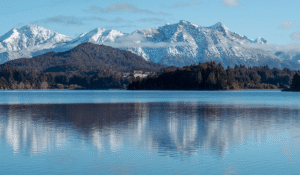When we think about lakes, we often picture calm, glassy surfaces reflecting mountains or forests. But beneath these peaceful waters lie some of the deepest and most mysterious ecosystems on Earth. The deepest lake in the world, along with others on this list, holds fascinating geological, biological, and historical secrets that captivate scientists and travelers alike.
In this article, we’ll explore the top 10 deepest lakes in the world, their locations, depths, and what makes them so extraordinary. Let’s dive deep — literally!
1. Lake Baikal – The Deepest Lake in the World
- Location: Siberia, Russia
- Maximum Depth: 1,642 meters (5,387 feet)
- Average Depth: 744 meters (2,441 feet)
- Type: Rift lake
- Formed: Over 25 million years ago
Lake Baikal isn’t just the deepest lake in the world — it’s also the oldest and largest freshwater lake by volume, containing about 20% of the world’s unfrozen fresh water. Its crystal-clear waters are home to over 1,700 species of plants and animals, many of which are found nowhere else, including the Baikal seal (nerpa).
Fun fact: During winter, the ice on Lake Baikal can reach 1 meter thick and becomes so clear you can see fish swimming beneath your feet!
2. Lake Tanganyika – Africa’s Deepest Lake
- Location: Bordering Tanzania, Democratic Republic of Congo, Burundi, and Zambia
- Maximum Depth: 1,470 meters (4,823 feet)
- Type: Rift lake
- Length: 673 km (418 miles)
Lake Tanganyika is the second-deepest lake in the world and the longest freshwater lake on Earth. Formed within the East African Rift Valley, it’s over 9 million years old. The lake supports more than 350 fish species, many of which are unique to its waters.
Because of its isolation and age, Tanganyika is often studied to understand evolution and biodiversity in isolated ecosystems.
3. Caspian Sea – Technically the Deepest Enclosed Inland Water Body
- Location: Between Europe and Asia, bordered by Russia, Kazakhstan, Iran, Turkmenistan, and Azerbaijan
- Maximum Depth: 1,025 meters (3,363 feet)
- Type: Endorheic basin (salt lake)
Although it’s called a “sea,” the Caspian Sea is technically the world’s largest lake. It’s filled with salty water and holds about 78,000 cubic kilometers of water. Due to its massive size and unique salinity, it blurs the line between a sea and a lake.
Fun fact: Ancient geographers believed the Caspian Sea connected directly to the ocean due to its sheer scale.
4. Lake Vostok – A Hidden Subglacial Lake in Antarctica
- Location: Antarctica (beneath 4 km of ice)
- Maximum Depth: 1,000 meters (3,281 feet)
- Type: Subglacial freshwater lake
Buried under more than 4,000 meters of Antarctic ice, Lake Vostok was discovered via radar in the 1990s. Scientists believe it has been sealed off from the surface for millions of years, making it a potential analog for life on icy planets like Europa or Enceladus.
Lake Vostok remains one of Earth’s most mysterious and untouched ecosystems, where unique microbial life might still exist.
5. O’Higgins–San Martín Lake – The Deepest Lake in the Americas
- Location: Shared by Chile and Argentina
- Maximum Depth: 836 meters (2,742 feet)
- Type: Glacial lake
Nestled in the Andes Mountains, O’Higgins–San Martín Lake is known for its stunning turquoise waters caused by glacial sediment. Its depth makes it the deepest lake in the Americas.
It’s surrounded by towering peaks, glaciers, and remote wilderness, attracting adventurers and photographers seeking pristine natural beauty.
6. Lake Malawi (Lake Nyasa) – The Biodiversity Hotspot
- Location: Between Malawi, Mozambique, and Tanzania
- Maximum Depth: 706 meters (2,316 feet)
- Type: Rift lake
Lake Malawi is the third-deepest lake in Africa and home to more species of fish than any other lake on Earth — over 1,000 species, most of which are cichlids.
It’s a UNESCO World Heritage Site and a paradise for divers and biologists exploring evolutionary adaptation and aquatic diversity.
7. Issyk-Kul – The Deep Mountain Lake of Kyrgyzstan
- Location: Kyrgyzstan
- Maximum Depth: 668 meters (2,192 feet)
- Type: Endorheic (saline) lake
Issyk-Kul means “warm lake” in Kyrgyz, a fitting name since it never freezes despite being surrounded by snow-capped mountains. It’s one of the largest alpine lakes in the world, fed by over 100 rivers but with no outlet.
Fun fact: Ancient ruins and artifacts have been discovered beneath its waters, sparking theories of lost civilizations.
8. Great Slave Lake – The Deepest Lake in North America
- Location: Northwest Territories, Canada
- Maximum Depth: 614 meters (2,014 feet)
- Type: Glacial lake
Great Slave Lake is the deepest lake in North America and the 10th-largest by area globally. The town of Yellowknife, the capital of the Northwest Territories, sits along its northern shore.
Despite its icy temperatures, it supports fishing, boating, and serves as a vital part of Canada’s freshwater system.
9. Crater Lake – America’s Deepest Lake Formed by a Volcano
- Location: Oregon, USA
- Maximum Depth: 594 meters (1,949 feet)
- Type: Volcanic crater lake
Formed nearly 7,700 years ago after the eruption of Mount Mazama, Crater Lake is known for its intense blue color and exceptional clarity. No rivers flow into or out of it — its water comes purely from rain and snow.
It’s part of Crater Lake National Park, one of the most breathtaking natural destinations in the United States.
10. Lake Matano – The Deepest Lake in Indonesia
- Location: Sulawesi, Indonesia
- Maximum Depth: 590 meters (1,936 feet)
- Type: Tectonic lake
Lake Matano ranks as the 10th-deepest lake in the world and Indonesia’s deepest. Surrounded by tropical rainforest, it supports rare aquatic species and serves as a vital freshwater resource for local communities.
Its serene beauty and clear waters make it an underrated natural wonder in Southeast Asia.
Why These Deep Lakes Matter
The deepest lakes in the world aren’t just geological wonders — they’re time capsules of Earth’s climate and evolution. They hold clues about ancient ecosystems, tectonic activity, and even potential extraterrestrial life analogs.
Key Environmental Importance:
- Act as climate regulators, storing carbon and influencing local weather.
- Serve as biodiversity hotspots, especially in rift lakes.
- Provide freshwater resources for millions.
Final Thoughts
Exploring the deepest lake in the world and its counterparts takes us on a journey beneath the surface — where pressure, darkness, and age collide to form breathtaking natural phenomena.
Whether it’s the frozen mystery of Lake Vostok, the warm alpine waters of Issyk-Kul, or the vastness of Lake Baikal, each lake tells a unique story of time, depth, and resilience.
So next time you hear the phrase deepest lake in the world, remember — it’s not just about depth. It’s about the incredible worlds that thrive beneath the surface.
Visit The Insight Vision Magazine For More Such Articles







